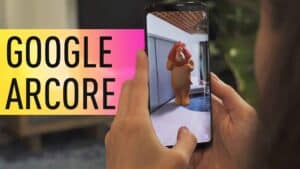Apple may have been first out of the AR gate (actually, Google was first with the slow-moving Tango project), but Google’s AR project is racing to catch up. Google’s latest comments on ARCore, their augmented reality platform, confirm that having it on a 100 million devices won’t be nearly enough.
Not with Apple muscling its way into the AR space.
Google’s AR project
Speaking at the recent Web Summit in Lisbon, the business and operations lead for Google’s VR unit, Amit Singh, laid out far-reaching plans.
Google had already confirmed that it plans to introduce advanced AR support to around 100 million devices before the end of this year, but the company’s long-term goal is to transform millions more Android devices into AR ready machines in the following twelve months.
The rollout won’t just cover high-end flagship devices either, as Google appears to be aiming for a mass market crowd with tech’s oft-heralded ‘next big thing’. “Augmented reality [will become] a core feature of most of Android over the next few years,” Singh said, noting that mid- and low-tier handsets will be updated over the next two years.
Unlike Apple, Google has a way to go. Right now, you have to hunt for ARCore – a bit like a Pokémon Go game. It’s only available on Google’s Pixel and Pixel 2 devices and the Samsung Galaxy S8 series.
Search the web for ARKit or ARCore videos and Apple’s platform has 50% more.
Of course, the challenge for Google’s AR dreams is that Android phones are all over the place. Apple’s lock-step march into the future may frustrate some users, but it means everything works pretty much on every phone. If Google can pull off getting AR on mid- and low-tier phones in the disorganized, Android landscape, ARCore will be a programming achievement.
And while the press focuses on the two tech giants, Facebook’s also a major player here. That initial push to have the camera be your AR device (a nice step, but not enough) may be followed with a combination of hardware and software. No matter what they do, they start by having 2 billion users on board.
AR everywhere
 With Apple on a tear with ARKit and Google’s AR plans driven by ARCore, you can expect to see augmented reality in students’ and consumers’ hands next year. And large-scale entertainment experiences will arrive. The creators of the wildly popular Pokémon Go will be releasing a Harry Potter Augmented Reality game in the near future.
With Apple on a tear with ARKit and Google’s AR plans driven by ARCore, you can expect to see augmented reality in students’ and consumers’ hands next year. And large-scale entertainment experiences will arrive. The creators of the wildly popular Pokémon Go will be releasing a Harry Potter Augmented Reality game in the near future.
Crowds of people back in the parks and out on the piers at midnight.
But AR on our smartphones is only an interim step to where we’re headed. The true end-point is interweaving the virtual with the real. And for that, we’ll need AR Glasses (okay, implants eventually, but I’m being practical).
Given the rumors swirling around Apple plans for a head-mounted AR device, expect that to happen around 2020. And no doubt, Google will be right behind them with a pair of Daydream Glasses.
No matter when this happens, we’re on the cusp of a new era of augmented reality. And in our ever so tenuous relationship with reality.

Emory Craig is a writer, speaker, and consultant specializing in virtual reality (VR) and artificial intelligence (AI) with a rich background in art, new media, and higher education. A sought-after speaker at international conferences, he shares his unique insights on innovation and collaborates with universities, nonprofits, businesses, and international organizations to develop transformative initiatives in XR, AI, and digital ethics. Passionate about harnessing the potential of cutting-edge technologies, he explores the ethical ramifications of blending the real with the virtual, sparking meaningful conversations about the future of human experience in an increasingly interconnected world.

